— Taylor Griggs contributed to this story.
If you use Portland’s streets, you know there’s room for improvement. From crumbling and cracked pavement on greenways, to debris-strewn bike lanes and cavernous potholes — basic street upkeep has fallen by the wayside.
There’s a number behind all of Portland’s unmet maintenance needs: $4.4 billion.
If you’ve spent any time doing transportation advocacy in this town, that number is likely very familiar to you. This statistic is often used by Portland Bureau of Transportation leadership and staff as an excuse to do nothing. One of the most effective ways to shut down requests from people who want a new project or program to be funded is for someone to say, “We’d love to, but we have a four billion dollar maintenance backlog to worry about.”
PBOT Commissioner Jo Ann Hardesty does this all the time. She recently cited the backlog as a reason the bureau has struggled to placate disgruntled maintenance workers. She also mentioned the backlog several times in our podcast interview last year, expressing that it’s one of the main things dragging down PBOT’s potential.
But the maintenance backlog didn’t start with Hardesty. PBOT commissioners and staff have long lamented about the seemingly interminable problem that keeps growing every year (see above).
“Continuing to maintain the assets…particularly the most costly facilities (like arterial pavement and bridges) is challenging for jurisdictions across the country as funding for ongoing repair, rehabilitation, and ultimately replacement were assumed to be covered by the federal gas tax, which was last increased in 1993 and which we know is woefully insufficient to keep up with aging infrastructure,” PBOT Public Information Officer Dylan Rivera shared with us in an email this week.
Politics don’t work in its favor either. Maintenance work is decidedly unsexy and there are no ribbon-cutting events for sweeping a bike lane. As Cathy Tuttle pointed out in a recent BikePortland guest article, maintenance “just doesn’t have the same political oomph that ‘new’ has.”
Another reason our roads are in such poor condition is because our transportation system strongly favors the type of vehicles that damage roads most. There are tens of thousands of extremely heavy cars, buses and trucks rolling over our roads on a daily basis, and as more people buy larger and heavier ones (EV batteries being the main culprit), the problem will only get worse.
The picture looks even more bleak when you realize that federal grant programs — a huge source of funding for capital projects — don’t pay for maintenance. That means PBOT has to use “discretionary” funding for maintenance, a source the agency has been forced to reduce by 9% in the last two budget cycles.
So what, exactly, is on this infamous backlog? And can the city’s current approach even begin to tackle it?
What does the backlog consist of?
PBOT’s Rivera tells BikePortland the $4.4 billion refers to the bureau’s “unmet need” – the calculation of how much it would cost to bring the bureau’s $18 billion in assets to fair or better condition in 10 years. According to this calculation, it would require the city to dedicate $440 million a year to maintenance for 10 years to get assets into that level of condition.
Taking up the bulk of this cost is unmet road maintenance needs. This includes $1.5 billion for busy streets and $1.8 billion for residential streets in various states of disrepair. A Citywide Assets Report released in 2019 deemed the majority of Portland’s arterials and local streets in ‘poor’ or ‘very poor’ condition. Other big contributors to the backlog include streetlights, curb ramps and bridges.
Not figured into these totals are the millions PBOT is forced to spend every year due to infrastructure damaged by incompetent and/or reckless drivers who plow over signs into poles with alarming regularity.
A 2013 city report detailing the condition of Portland’s pavement said it would cost about $750 million over ten years to get roads in proper condition. In 2015, the backlog totaled $1.2 billion, increasing to more than $2 billion by 2017. A little more than five years later, we’ve doubled that price. This proves a dire warning we often hear from PBOT staff: the longer we wait to fix roads, the more expensive it gets.
Potential solutions
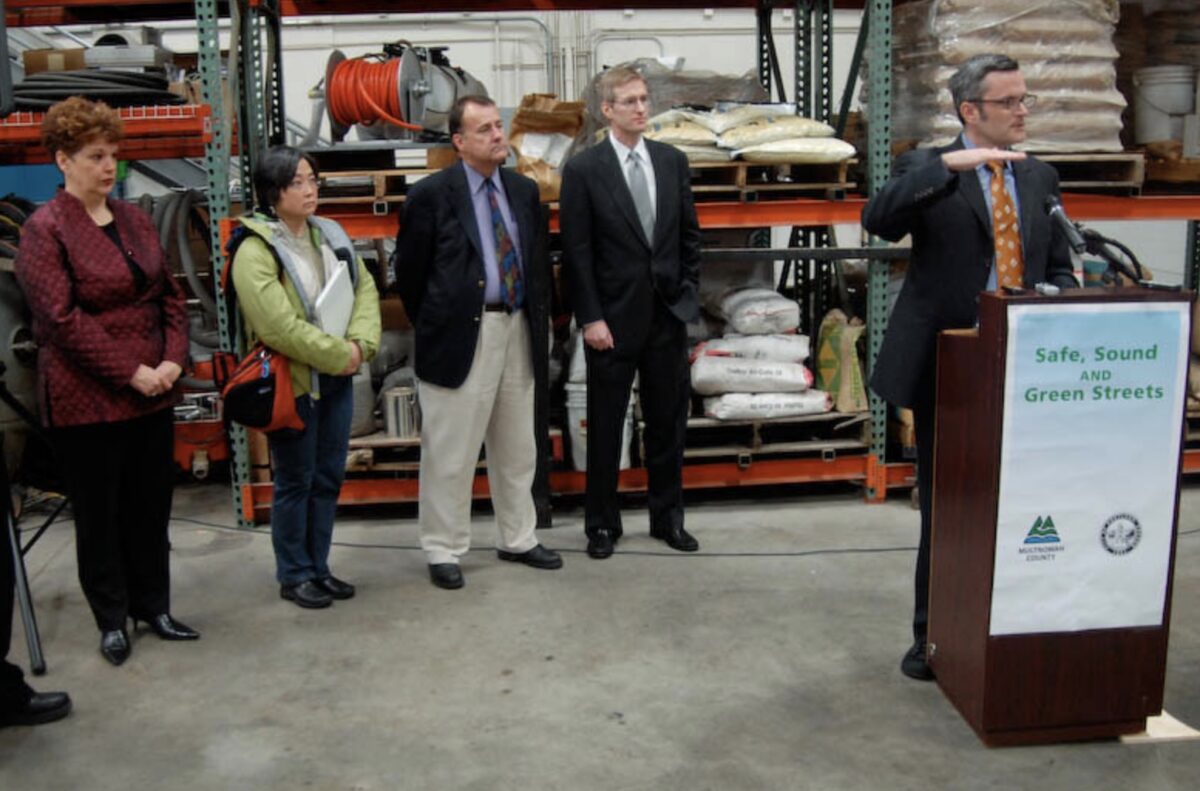
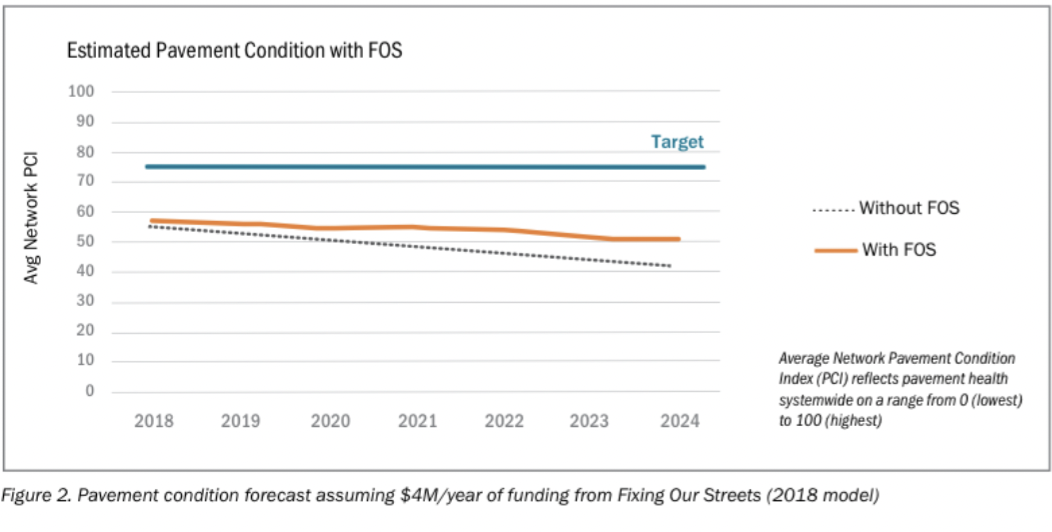
The people running Portland’s transportation system have championed a variety of efforts to pay for maintenance over the years. Way back in 2007, former mayor Sam Adams pushed a “Safe, Sound and Green Streets” fee initiative for Portland households that would have raised money for maintenance work (back when the deficit was still manageable). After that initiative died, former PBOT Commissioner Steve Novick advocated for a similar program in 2013 – a universal “street fee” – which also never came to fruition.
Finally, in 2016, Portland voters approved the Fixing Our Streets program as a way to fund street maintenance projects using a $0.10 per gallon fuel tax and a Heavy Vehicle Use Tax. Policymakers knew this program wouldn’t be able to solve every problem in the city, but it was a start. And like many PBOT funding sources, it has a double-pronged approach. Not only is the tax a source of revenue, but the hope is that increased fuel prices will incentivize people to drive less so less pricey maintenance work would be required in the long-term.
The backlog has only grown since the passage of Fixing Our Streets. Even so, PBOT says the money has been put to good use to stave off some of the worst outcomes (see chart at right).
“The Fixing Our Streets program has made a big difference in preserving and extending the life of the city’s pavement, in addition to providing some critical safety improvements,” Rivera said. “No one ever said FOS alone would be enough to solve the maintenance backlog that took a half century to produce.”
So, in a scenario in which everyone either rides a bike or drives an electric vehicle (a utopia for many advocates), the FOS money would run dry fast. That’s where the city’s Pricing Options for Equitable Mobility (POEM) effort comes in. Or, was supposed to come in. Launched in 2019 and adopted by City Council in 2021, the POEM Task Force outlined several ways PBOT could raise revenue. Unfortunately, the recommendations of the task force have yet to move forward.
One new fee PBOT has begun to collect (which wasn’t technically part of POEM) is a new parking fee that was created out of desperation following a massive decline in drivers filling meters during the pandemic. But that fee is estimated to collect just $2 million, a drop in the bucket.
What now?
The backlog is as bad as it’s ever been. We have less money than ever. And the morale at PBOT’s Maintenance Operations division is at its nadir.
It feels like PBOT and City Hall’s courage to implement the new revenue ideas from the POEM plan is diluted by their fear of losing out on the car-based, cash cow, status quo. But the sooner we rip off the band-aid, the sooner we can heal our streets and our budget.
In the short-term, we must get PBOT’s Maintenance Operations group on better footing. This has nothing to do with a lack of funding and it goes beyond looming threats of a strike. We’ve recently heard about a lack of trust between staff and leadership, a dysfunctional institutional culture, and eye-popping staff turnover rates. This constant reshuffling of staff is very disruptive to work crews and their programs, and leads to less work getting done. Our fingers are crossed that new Maintenance Operations Director Jody Yates, who was hired in February, can right the ship.
We also must charge people more to use our streets. With inflation and income inequality at all-time highs, and with transportation not even being on the political radar in Portland these days, that will be a tough pill to swallow.
To make it easier to swallow, we should consider a different the narrative around the issue. Our goal shouldn’t be to raise more money to do more maintenance; the goal should be to do less maintenance. The situation is unsustainable not because we lack funding, but because we are living above our means. We spend too much money fixing damage from vehicles that we can’t afford to support any longer, and we don’t do enough to make things we can support — like biking, walking, and taking transit — viable options.
Portland has a long legacy of supporting carfree spaces. Former Mayor Vera Katz declared September 14, 2004 as “Portland Car-free Day.” In 2008 we hosted the international Towards Carfree Cities Conference. And even the recent POEM initiative had, “Our system today over-prioritizes cars” as one of its foundational principles. But despite years of rhetoric and advocacy we still haven’t fully embraced the idea of permanent carfree streets, despite the fact that every time we dip our toe in the water — with programs like Sunday Parkways or recent plaza and public safety projects — it feels good.
We need more attention on the problems we face today and the political will to do things differently tomorrow. The maintenance backlog excuse should not be the end of the conversation — it should be the start of a new one.

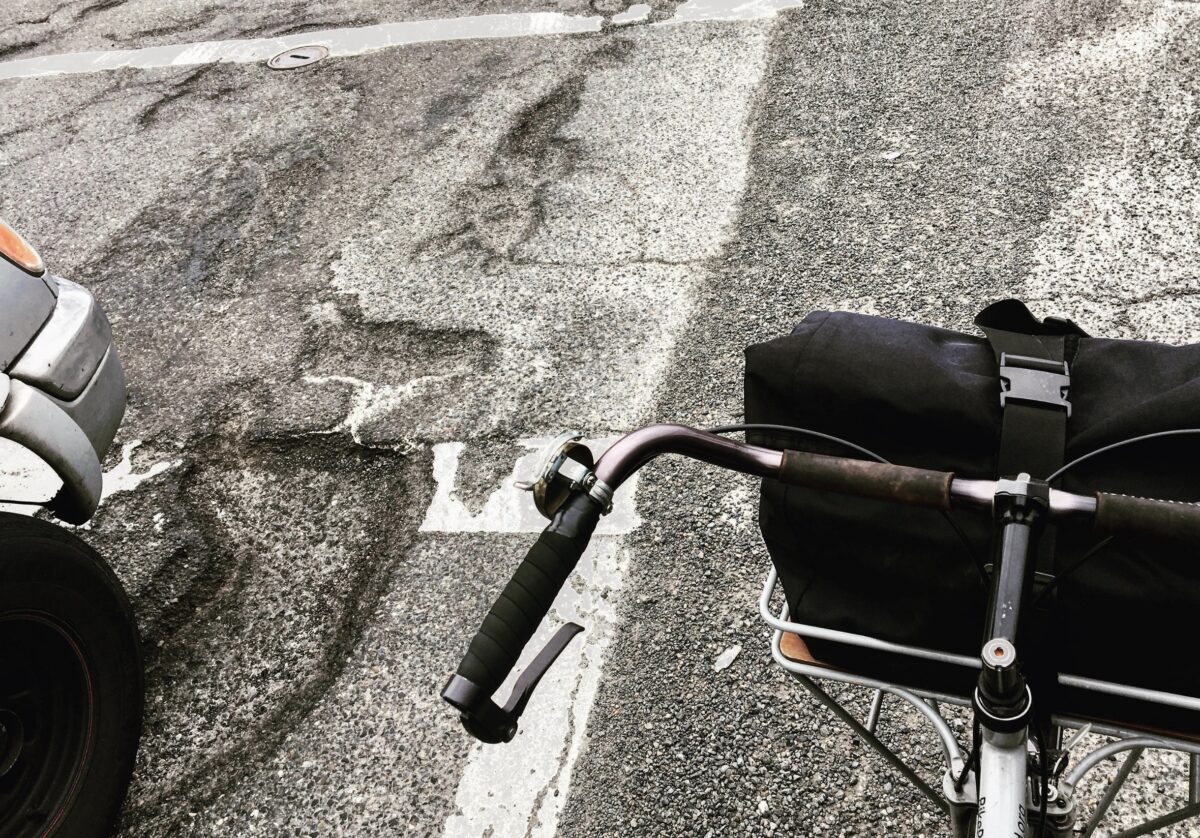

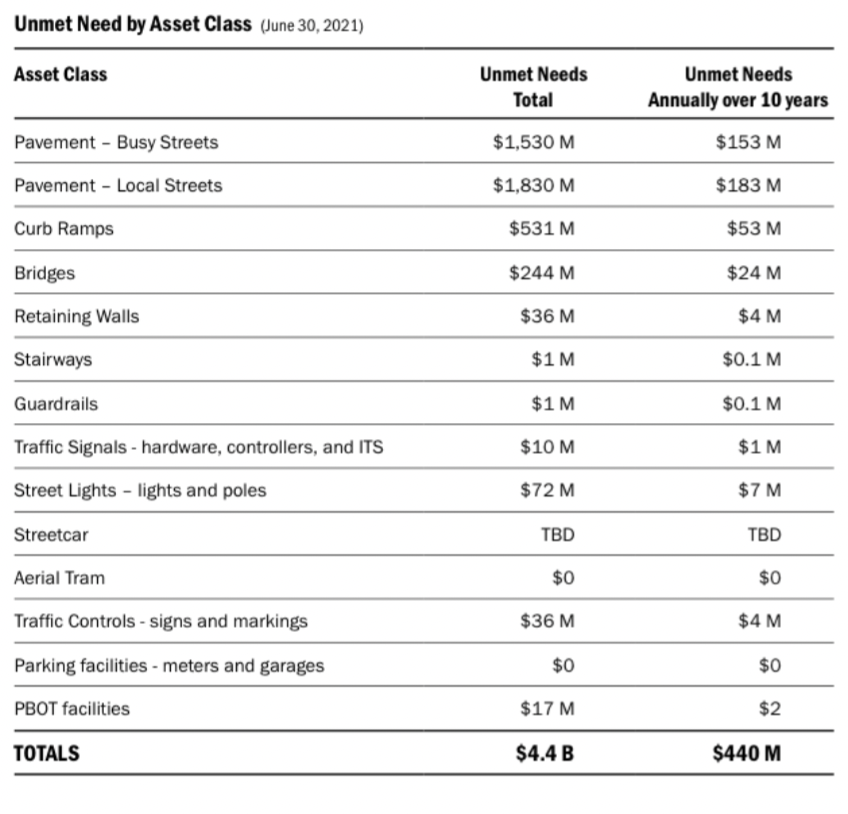
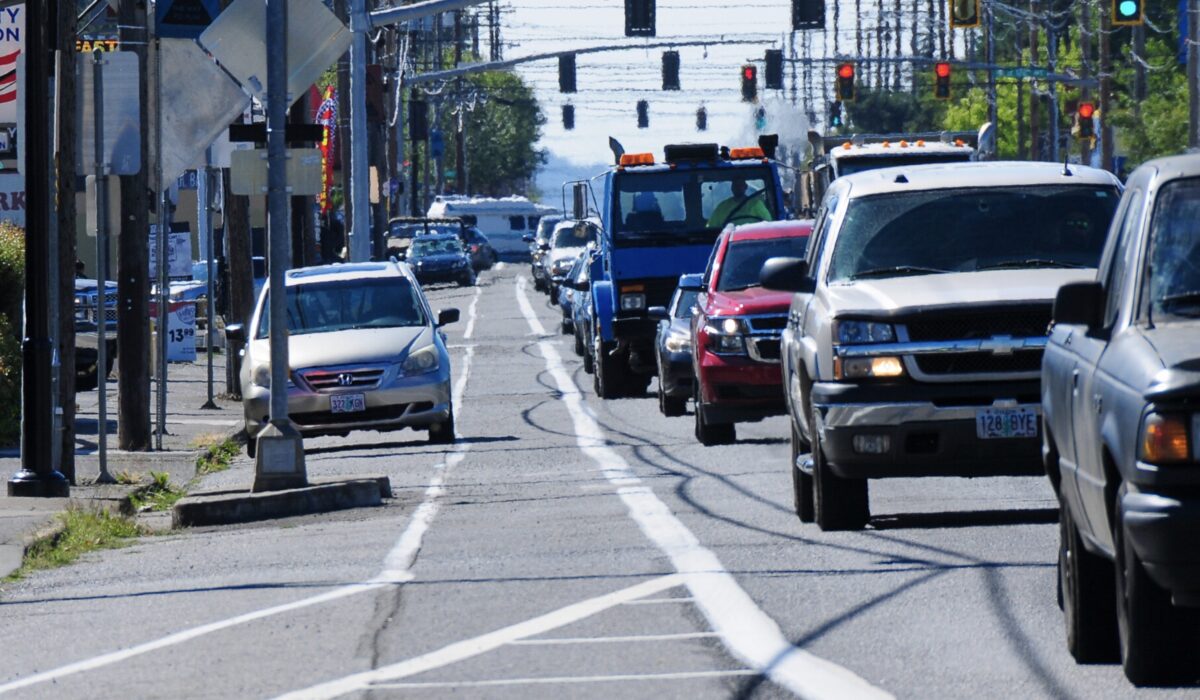

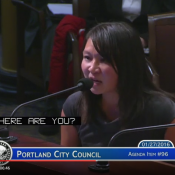
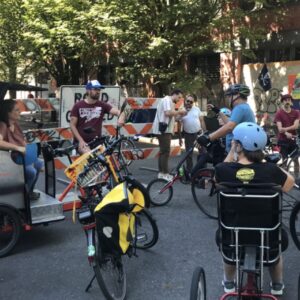

Thanks for reading.
BikePortland has served this community with independent community journalism since 2005. We rely on subscriptions from readers like you to survive. Your financial support is vital in keeping this valuable resource alive and well.
Please subscribe today to strengthen and expand our work.
I like the idea of attacking the problem by reducing the amount of street that needs to be repaired, but it is hard to imagine closing enough streets to make a dent in the deficit. IN terms of raising money, it seems like there a couple of options I have seen much of a push for: A large fee for studded tires paired witha ban on studs within City limits without a permit. The permit could be a daily or annual sticker like a snow park pass. Second; a vehicle weight fee paid as part of registration fees: pay per pound. Third, an emissions fee paid at DEQ testing- the more you pollute, the more you pay. I think more gas taxes would be good, too.
Not to mention all the areas of the city with _no_ sidewalks (one of which I live in)
Heavy vehicles should have to pay their fare share, as my occationally used mid 90’s car and my bike do very little damage to the roads.
I’m a transit rider and I see the damage the VERY heavy Trimet buses do to Portland streets. Should Trimet pay to mitigate the damage their buses cause?
trimet does pay to mitigate their damage. At least in some respects. They give PBOT extra money so PBOT can build those concrete islands at bus stops. Those islands are specifically due to the heavy weight of the buses and the extreme impact it has on pavement.
The dirty little secret of buses is they are extremely hard on roads and they cause a lot of wear and tear. Much more than standard cars and trucks.
Don’t worry, as per current rules, diesel vehicles with a GVWR over 8500lbs get an emissions waiver. I had a similar experience with a gas powered RV as well. So the vehicles that weigh the most, and likely pollute the most, get a pass!
Depave Portland Streets!
Those are all good ideas except we’ll get something like the yellow vest movement in France if it is actually successfully implemented (i.e. not trivially circumvented). Also it seems unlikely Portland can do most / any of those things because you don’t register your car with the city. But it’s also true Portland isn’t the only city having these problems, so doing it statewide is reasonable.
As to closing streets, it simply shouldn’t be possible to go anywhere that isn’t a main arterial. It seems like they could close a massive number of streets. By closed I mean only on one end, so people can still get to their house. Local streets were the biggest single cost, but you’re right even if they brought that down to zero there would be like a $3 billion deficit.
Don’t forget the ULF – Utility License Fee – for when utility companies cut into the street, the city collects enough money to repair and eventually rebuild the streets. When it was passed way back when, it was set up to completely eliminate the maintenance backlog forever, and it has since generated more than enough revenue to do just that, but…
… as usual, when city council finds a new source of revenue, it finds new ways to divert that revenue. On the day the ULF was passed, they diverted 20% to general revenue, to pay for police and fire, then 40%, and eventually 97%. Currently no more than 3% goes to PBOT.
The ULF fiasco serves as a warning – unless the state legislature prohibits it, the city council will “in an emergency” divert any and all funds out of transportation whenever possible. Street maintenance is not a City Council priority – if it was, they would have long ago defunded police, fire, and parks to pay for the backlog, as many other cities have quietly done.
Wow.
That is an amazing and disheartening piece of Portland history
Ahahaha, police budget strikes again! There was a phrase, slogan for how we could take some of that money and use it on something it was better suited for. But if you say it clearly and succinctly, people will come out of the woodwork to try and convince you that “other people” find it confusing and misleading.
But also it’s worth asking, how was that even possible? How can a measure be passed and then just literally stolen from people to use on something else? That should be the kind of thing that has people a little more upset. I didn’t even know about this.
Wow the last I read about this it was still at the $2 billion mark. Fixing our streets brings in $18.5 million a year. So we would need a $2.38 gas tax to get the $440 million a year we need for ten years. Besides being unrealistic it’s also rather regressive.
If we went the property tax route using Measure 26-213 as an example we would need a $7.33 property tax per $1,000 assessed value. Which would cost the median homeowner $1,384 a year roughly a 25% increase in their property taxes.
I’d say both of those are non-starters and any politician seriously trying to pass either or some sort of combination would be run out of town on a rail. Unfortunately this, like so many other issues in our city, looks like it will need a Federal solution. Everyone could stop driving tomorrow but the damage is already done, will continue to get worse and more expensive even without sov road users.
Cities and states shouldn’t be able to build new infrastructure if they can’t maintain what they have.
Just think, if we could only divert the billions spent on MAX how quickly it could be taken care of.
Having ridden MAX for 15 years and bus the rest of the time, we could be so better served by a flexible bus system than the fixed, easy to breakdown (because TriMet thinks maintenance is a bad word like PBOT) MAX system. How much better transportation funds could be spent on buses, bus lanes, and redoing the streets to be safer for the same amount as a single MAX line.
C’est la vie.
I’m all for removing lanes for drivers to use for public transit but that’s rarely what happens is it? Sure we have some rose lanes in select spots now but they’re not the full length of a bus route. Without the will to actually take miles of mixed use roads away from drivers funneling money from the Max would be pointless.
Also I’ve lived along my fair share of Max lines and can’t remember for the life of me Trimet needing to re-do the actual tracks every few years. Seems like despite the Max weighing orders of magnitude more than a bus it requires significantly less maintenance of the surface it runs on. All of that is kind of moot though since federal funds that go into Max development are almost exclusively for capital investments something I doubt would go to repaving Powell and a handful of blocks of dedicated bus lanes. Not that ODOT would allow such a travesty.
Nearly every small-to-midsize European city has a tram network that puts our light rail to shame because they know that rail transport is vastly more efficient, comfortable, and durable than buses.
The federal solution you speak of, without drastic changes to existing land-use patterns, would be just another subsidy for car-dependent sprawl. If a federal bailout somehow fixed all our streets tomorrow, we’d need another one in thirty years or so. Ditto for every other major metro area in the country. That could happen if we completely defunded the military and ended corporate welfare entirely, but a more practical, local alternative is to allow dense, mixed-use, walkable neighborhoods everywhere in the city, build reliable, frequent transit, limit the movement of cars, and tax the land instead of the buildings on it. This would have the added benefit of drastically reducing our GHG output and improving public health.
I’m all for shifting away from car dependency but that still doesn’t change the fact that the cost to repair our existing infrastructure is outside of our ability to pay for it without significant tax increases. The roads need to be fixed even if no one drives personal vehicles anymore. The state could make a dent in it if they stopped expanding our freeways but we’d still need federal assistance to fix these issues statewide.
Not repairing it until we have different land-use patterns is equivalent to letting it fall a part until people can’t drive anymore. I’m not sure that’s the best approach to changing our habits.
My point is that a change in land-use patterns to allow more dense, mixed-use neighborhoods and/or taxing the land itself is what will generate the money to pay for the stuff we need: https://usa.streetsblog.org/2013/05/21/taxes-too-high-try-building-walkable-mixed-use-development/
I agree with your aspirational goal of fewer heavy vehicles [especially fossil fuel powered ones] on our streets. But there’s something major missing from this article: the truth that “insufficient revenues” is not some objective fact– it’s a completely socially constructed problem.
If city officials had the political courage to raise the needed revenues so that we can maintain our streets–an immensely valuable public asset–so that they don’t fall apart further (increasing the future cost even more), we could have BOTH well- maintained street AND world- class bicycle and pedestrian infrastructure. It’s straightforward: figure out how much it will cost to have a functioning city, and then raise that much revenue. At least Steve Novick understood this when he tried to create a new street fee/tax.
This article seems to partly accept the neoliberal narrative of permanent scarcity. But the truth is we’re just not raising enough revenue from corporations and the wealthy to sustain our infrastructure, or our society.
One obvious untapped source of revenue for road/ street maintenance in Portland would be a tax or fee on every private utility and construction company that digs up city streets to install or replace utility lines, or uses backhoes or other heavy equipment. We can all see how those activities cause streets to fall apart. The gains are privatized, while the costs are socialized.
So let’s put an end to this false notion that there “isn’t enough money. ” The money is there–what’s missing is the political courage and vision to do what’s needed to actually capture those resources, and finally put them to work in restoring our public sphere.
Hi DSKJ,
You wrote:
It might seem that way, but that is not what I believe nor was it ever my intention to convey that. Ever. I agree with you that the entire premise of funding scarcity is often just bullshit and used for the same reasons I think the excuse itself is used.
Thanks, Jonathan. I appreciate the response, and the clarification.
Land value tax would solve this.
Good idea! Per David Hampsten’s comment above yours, unfortunately it sounds like we’ve already tapped that source of revenue to fix our streets. But City Council stole it for PPB and the general fund:
https://bikeportland.org/2022/11/02/whats-behind-pbots-4-4-billion-street-maintenance-backlog-excuse-366371#comment-7483229
I haven’t been able to find any other sources for this information based on a few quick sources, but David tends to be pretty knowledgeable about these things.
I’ve heard of cities here in NC, particularly smaller cities with far less bureaucratization within their local government and smart city managers, that have used their crime prevention and vehicle maintenance funding to pay for better street lighting and repaving local streets in the poorer parts of town where there are more fire and police calls – better lighting and smoother streets not only reduce the wear and tear on city vehicles, but on the long term it also increases property values and tax revenue, as well as home ownership turnover. The theory is that increased gentrification leads to reduced crime and higher city revenues, particularly in chronically poor districts. The trick of course is to control that gentrification without causing rampant out-of-control homelessness.
From the linked POEM article:
“Now that the POEM recommendations have been adopted, PBOT and BPS are bound by the resolution which calls on them to return to council within nine months, “with an update on all strategies and an implementation plan for the nearer-term equitable mobility fees and investments.””
Did this happen? I don’t remember hearing anything more.
When I served on the PBOT Budget Advisory Committee in 2012, we were told the maintenance backlog was just under a billion dollars ($942 million if I remember correctly) and not the $1.47 billion on the chart, which make me suspicious about the other numbers post 2011. Why the huge jump from 2011 to 2012? PBOT stopped fixing streets in 2008 as the long recession started, though they had scaled back for years, but there was no reason for such a large jump in 2012. My guess is that the city found a new accounting method in 2019 to use ARPA covid-stimulus funds and then recalculated the figures for previous years to justify some sort of grant. There is a huge backlog, no doubt about that, but certainly not $4.4 billion, probably not even $3 billion, I’m guessing closer to two.
Maybe there’s too much being spent on studies and communications.
Better put together a task force on budget allocations for studies and committees. Oops looks like the backlog is 5.4 billion now
This article made me think that Portland is just living out the inevitable outcome of low density construction that was outlined in Not Just Bikes’ video – Why American Cities Are Broke, The Growth Ponzi Scheme. $1.8B needed to bring residential streets back to good order to serve homes and businesses that would be overwhelmed if adequate taxes were imposed to pay to upkeep the facilities that allow their low density neighborhood to exist. Further underlining why we desperately need to accelerate dense building right now. What happens to our cities when they start to go bankrupt? How many cities will need to be bailed out by the state and federal govt, and what will that do to those budgets? All for the sake of not sharing a wall..
yes! That’s a big part of it Zach R.
And that’s another reason why I’m trying to stress a new narrative that connects these kind of dots to the maintenance discussion.
Jonathan, this is a huge reason why I subscribe to BikePortland. It’s great to see those broad lessons brought down to the local decision level, which is where the change will actually be made. Keep up the great work!
An additional thought that always bugs me on this topic, is the cognitive dissonance many Americans demonstrate when they profess to believe in capitalistic ideals, yet refuse to pay their direct share of the costs (e.g. free parking, completely subsidized roads, inefficient utility expansions, aversion to tollways, and much more). It frustrates me to no end. Kudus to those who can wade through it.
Give me a break the equity of the average Portland home went up ~33% in the past two years. The vast majority of home owners can afford to pay system maintenance charges (and we can provide accomodations for those that can’t).
As for businesses, no for-profit business deserves to use the commons without paying their fair share.
I see where you’re coming from. I live in one of those single family houses in town and could easily absorb the tax increase to just fix it. But if your house goes up in value, that doesn’t somehow increase your income or lower your mortgage payment, it would *only* increase your tax burden. Home prices going up so fast is not an argument in favor of getting this funding from taxes. People who bought 5 years ago near the top of their budget (or whose income isn’t rising with inflation, i.e. a pay cut) may have more equity but that doesn’t mean they can afford a $100/month increase.
Yeah we should tax land owners more (and accommodate people who need it like you said), and more taxing corporations, but also it’s just not sustainable to have this much infrastructure for such low density housing.
I agree. Single unit homes and duplexes (e.g. the so-called missing middle) should be illegal in inner Portland and tall sun-blocking apartment buildings should be legal everywhere.
That is just pure BS, having more ‘equity’ in your home doesn’t translate into an ability to pay more taxes and fees, if anything it has the opposite effect.
The classic definition of gentrification is when real estate values (i.e. ‘equity’ in your home) increase faster than the ability of occupants to pay the tax increases associated with higher home values; not being able to pay the higher taxes is what drives lower income residents out of the neighborhood.
On top of that, any new-found ‘equity’ in your home can typically only be realized when you sell, it doesn’t do you any good if you are just living there trying to get by.
But I don’t expect renters to understand any of this.
If you have trouble paying your system maintenance charges (SMCs), you could always sell and become a R-E-N-T-E-R.
Ever heard of MEW?
Homeowners extracted $175 billion in equity from their homes in Q2 2022. You could do this too, FDUP.
(I have less than zero sympathy for equity rich homeowners.)
https://calculatedrisk.substack.com/p/mortgage-equity-withdrawal-still
The problem is that property taxes themselves discourage building more densely on a given piece of land. Taxing the value of the land itself rather than the “improved” value of what’s built on it would remove this barrier.
People who build apartment buildings already pay (SDCs). My proposal of system maintenance charges (SMCs) for equity-rich homeowners is not a proprety tax. For example, these charges could be assessed any time a property is sold or modified.
In California they call these parcel taxes. They’re assessed at a flat rate per square foot of owned land. So they hit condo dwellers differently than folks who own SDH.
How about a progressive fee that targets windfall profits (large capital gains). This would protect those who have small gains and/or low-cost housing.
Assessing new fees any time a property is modified may raise new funds, but it will also discourage building anything on that land. Not great when we need tens of thousands of new housing units yesterday.
Sure, you can ‘borrow’ against your ‘equity’ *rolleyes*; the cost of which keeps going up b/c the Federal Reserve has their heads in their asses, and are raising interest rates when we should be taxing corporations on windfall profits.
So many places to begin, how about: Big Oil, Big Pharma and Big Ag to start? Then add in Mining, Financial Services, Airlines, Motor Vehicle manufacturers, etc., etc.?
Your proposal would force people to capitalize their home equity, which means taking out a loan and sending the payments to Wall Street instead of spending it locally, so the city can subsidize the asphalt industry.
I think your visceral hatred for anyone not living in poverty is clouding your judgment.
I don’t disagree with most of your argument Soren. Although I wonder if you could realistically/politically pass a policy that decided who would have to pay and who would be exempt from paying the maintenance fees. I don’t have sufficient faith in our political system that those with influence wouldn’t be able avoid paying their share.
I believe it would be better to apply the policy equally across all properties (perhaps with some equation taking street frontage and lot size into account) and ramp it up over time to allow people to see the writing on the wall and adjust their strategies accordingly but fast enough to get this $4.4B maintenance backlog dealt with. Ultimately low density housing is very expensive for the city to maintain, regardless of the income of the homes on the street.
How we get from where we are now to the pie-in-the-sky ideal, solvent city of tomorrow without completely devastating low income people is going to be the hat trick of the century.
The majority of the increase in inequality in the USA (and other wealthy nations) is a result of housing price appreciation (housing share of capital income).
https://www.brookings.edu/wp-content/uploads/2015/03/1_2015a_rognlie.pdf
Moreover, increases in housing prices correlate strongly with unraveling of social safety nets and decreased access to social resources.
https://academic.oup.com/oxrep/article-abstract/24/1/1/5140987
If we want a society that funds the commons and creates some semblance of a social contract we will eventually have to go after this hoarded and unproductive capital income. I agree with you that this is unrealistic given our current sociopolitical system but, then again, I don’t think our current system is particularly stable.
Land value tax wold solve this.
Taxing land value and not property value is regressive.
Why not both.
Why are any taxes including property and land taxes levied on your average citizen? Corporations should be paying the bulk of the taxes in this country, for so many reasons; but globalization, corporate lobbyists and lawyers have successfully circumvented that. I understand that the uber-wealthy like Bezos and Musk also don’t pay their fair share, but my take on that is that they are both protected by their umbrella corporations. I’m sorry, but Soren’s war on the middle class is totally misdirected, as Sigma has already pointed out above.
How is it “regressive” to tax an apartment building 100x more than a surface parking lot in the midst of a housing and climate emergency?
D’oh! I meant “progressive”.
Ban studded tires and watch the rate at which our roads deteriorate slow to a fraction of what it is now.
I think you hit the nail on the head here. It isn’t talked about nearly enough how nasty studded tires are for our roads. We’d still have to address the existing backlog, but I bet we would watch the rate at which it grows plummet to almost nothing.
Now, I think we also need to do something about the proliferation of oversized vehicles like SUVs and trucks, but it would address a large portion of the problem. Equating the damage caused by a Honda Civic to that caused by a Dodge Ram is ludicrous.
Studded tires have been an issue for decades now. They are needed for at best a few days a year but Oregon lets people roll on them for fully half the year. Now that many people can work from home in inclement weather they are needed even less. Studded tires destroy roads.
If I were king, I would ban studded tires except as needed by workers to get work done. The employer would authorize studded tires and pay a fee to cover the actual damage they cause. So the burden would fall on businesses, not individuals, and there would be no individual right to use studded tires.
You forgot to mention the contribution urban sprawl has to lack of funding for infrastructure maintenance. It is simply a lot more cost effective to maintain a square mile with 8k residents than it is to maintain a two square miles with the same number of residents. The tax revenue simply goes further as density increases. Density can also decrease car usage if done correctly with 15 minute neighborhoods. This is also one of the reasons why park and rides at rail stations are generally awful urban land use.
More validation of Strong Towns’ work on the financially crippling effects of car dependency. There’s just no way to pay for essential maintenance when most of your city’s land area is low-productivity (because low-density) sprawl.
The only viable path out of this mess that I can see is adopting a more European style of urbanist development with mixed-use zoning and drastically increased density, coupled with pedestrianized town centers, frequent transit, and strict limits on automobile movements.
The number one thing you can do for maintenance is to prevent damage. Studded tires are unnecessary in Portland, yet, take a look at the roads, you can see the ruts caused by studs. I tried to get an initiative on the ballot to ban studded tires. Preserving OUR roads and saving money for bicycle infrastructure was my goal. Les Schwab hired lawyers to fight me all the way. Politics can be dirty and corrupt. People had the right to vote how they wanted to spend money. Don’t take your car to Les Schwab, just saying.
“Former Mayor Vera Katz declared September 14, 2004 as ‘Portland Car-free Day.'”
Ha! People should come out to SW Portland and see how drivers react when *any* limitation is imposed on their INHERENT RIGHT to drive everywhere. This idea of limiting driving as a way of driving down the maintenance backlog is a complete non-starter. People will give up driving their cars only when their steering wheels are pried from their cold, dead hands.
Car Free Day was a great idea but it was only one off-the-beaten-path city block for one day of the year, and it mostly reached people who already believed.
Thank you, Taylor. This is a well written article. I am glad that somebody is writing about this.
The idea that streets are ‘assets’ is totally incorrect. A street is a liability: you are essentially promising to keep the street maintained forever
The ‘asset’ is the ability to tax adjacent property owners.
from 8 years ago: https://www.strongtowns.org/journal/2014/8/19/is-a-street-an-asset.html
more has been written since but it didn’t come up in a quick search.
I wonder if this mindset was taken coming in how the article would have come out
Thank you, Allan, that was a good article you linked to.
Is the overall condition of Portland roadway pavement a major concern for bike riders, though? With higher volume-lower pressure tires, non-smooth pavement is fine to ride on. Think European paver and cobble roads. This seems like a problem created by – and suffered by – cars, trucks, and buses. Should cyclists really want $4BN of city funds to be diverted to work that largely benefits driving?
I don’t believe this is a serious question, but I’m answering anyway. If you’re serious, well… I assume you never ride on paved roads.
Yes, John, the condition of Portland roads is a major concern for bike riders. Consider that car & trucks generally have shocks, and 4 tires. Compared to bikes, or any other type of cycle, you are very insulated from the road. You’re barely going to feel that pothole. A car or truck that hits a pothole, is also not likely to get stuck in it, or to flip over. Portland’s paved streets are not European paver and cobble roads, that would be a whole different kind of riding.
Excuse me while I die laughing. Again, how often do those drivers flip over, or spin out just because they hit a pothole?